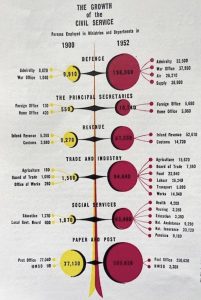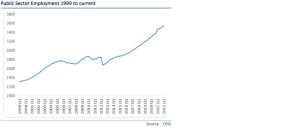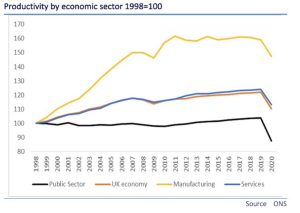IN A SPIRIT of reconciliation, I wish Liz Truss God speed. There is much to be done. I take her at her word that her Government will be a small one, weaving a distinct path from the regulatory EU Leviathan and one where the state concentrates on freeing the people to grow the pie not redistributing an ever smaller one.
I have argued he challenges facing this country go well beyond the merely economic but perhaps the keystone is to control the run-away state that, despite accounting for almost half the entire economy and regulating into every nook and cranny of life, is generally so unbelievably incompetent in what it actually does. In almost all respects, everything the State touches falters quickly into failure, overspend, regulatory slight and queues.
A good government will not only cut the scope of the state but markedly increase the bang for the buck in terms of both service and outcome. In today’s Britain such a task is urgent given the chronic productivity and service failure offered currently.
To put some context to the socialist state we are in I recently discovered a fascinating issue of the Economist,published as a Coronation souvenir issue, in 1953. Fascinating as it provided a snapshot of the nation’s bureaucracy just after war contrasting it with 1900, a time close to the apex of British power. The numbers are illuminating indeed.
The Economist Coronation Issue may 30th 1953
Source: The Economist
It is staggering to consider that in 1,900 the Foreign Office employed just 130 individuals, while the Home Office workforce was 420! But again, there was waste then too. What on earth did those 180 agricultural civil servants and 290 ‘Office of Works’ civil servants actually do?
Fifty years later and despite the relative decline in British power the civil service had exploded. A whopping 4,200 in health; 15,670 in agriculture and 5,060 in the Home Office. Dreadful.
But 1953 has nothing on today. 83,000 in the Department of Works and Pensions, 81,000 in the Ministry of Justice, 68,000 at HMRC and so it goes on. In 1,900 there was the quill, in 1953 the Parker Pen, today it is digital.
The chart below highlights current civil service numbers by department. Your starter for 10, can you actually name what those initials stand for – and for the bonus, which ones you would abolish? (Answer in plural, a single department is not an acceptable answer.)
Civil Service Staff numbers by department March 22
Source Institute for Government
We hear of a wicked right wing Government strangling ‘our public sector.’ The reality is an explosion in the state and public sector employment on an unprecedented scale. The chart below is just as illuminating as the table published in the Economist of 1953. The data comes courtesy of the Office of National Statistics.
The ONS confirms public sector employment stood at 2.3million in 1999. By the time Cameron came to power in 2010 public sector workers had grown by half a million to 2.8 million. But that was chicken feed with what Conservative governments did in ‘austerity Britain.’ Today 3,542,000 people work in the public sector – seven hundred thousand more than when the Conservatives came to power and a staggering 52% growth compared with 1999.
I challenge readers to say exactly what benefit we have had for this explosion in the state sector? It’s a genuine question. What areas of Government is actually working effectively?
Perhaps it is the Home Office control of migration policy? Perhaps it is the ease of getting a GP appointment?
Perhaps is the ease of speaking to the local council and not being told one might expect an e-mail response in 14 days as ‘in this difficult period we need to stay safe.’
Perhaps it is the NHS outstandingly short waiting lists as a result of spending almost £10,000 per year per family on health (that is not a typo).
Perhaps you have a better idea?
Even the Government’s own statistics make grim reading. ‘Inputs’ (that’s your money in plain English) are up 20% since 2019, outputs are claimed to be up around 10%, with productivity down 10%. This, is inexcusable on any analysis, given performance and outcomes both absolutely and relative to the private sector.
It almost certainly underestimates the real situation, for is a theoretical ‘zoom’ school lesson or GP call as good as the real thing? A productivity failure of that magnitude is quite an achievement when the state takes it upon itself to spend well over one trillion pounds per annum.
Taking a longer term view, as outlined in the chart below, public sector productivity is lower than 1999 and massively lags the private sector. These figures are shocking and may be an underestimate, particularly if one considers public sector performance over the last 24 months in terms of the NHS, education and other services offered.
The truth is the last 25 years (13 under Labour and 12 Conservative) have seen the balance of the state move inexorably from private to public provision with almost universally catastrophic consequence. If anything the trend to command and control socialism has been greatest under Conservative rule.
Liz Truss has written some wise words on addressing the size and scale of the state. It is now beholden on her to deliver. One of the first challenges will be to ensure that the planned public sector unions’ winter of discontent is sent packing, not out of some desire to cut real wages but to be clear there can be no pay rises without a commensurate productivity gain – and there has, in aggregate, been none.
Today’s public sector is so far behind the curve that the scope to take £100bn-plus of cost out should be simply the easy part to catch up with where an effective state should be.
Truss’s premiership will be defined by her approach to the entitled public sector unions. Will she stick or twist? If the latter, she will embed abject failure and inflation into the system – which will ultimately devour her Government. If the former, with a well-reasoned analysis of how the colossal spending pledges make for very poor outcomes, then linking pay increases to genuine step changes in scale and efficiency, she will have done this nation a great service.
The public sector is out of control. It’s not a question of targeting 1% productivity gains but a question of an entirely new approach and considering the scale of what the state actually does. A good start would be to analyse exactly why we need over 50% more public sector workers than we did in 1999 and exactly what extra families have gotten for this. There is huge scope to re- engineer. Succeed, and the scope to grow the cake through productivity gains is immense. Fail, and the future is inequitable, poor service, high tax and increasing decline.
Ewen Stewart is a City economist whose career has spanned over 30 years. He is director of Global Britain and a co-founder of Brexit-Watch.org.
7 September 2022
Ewen Stewart






